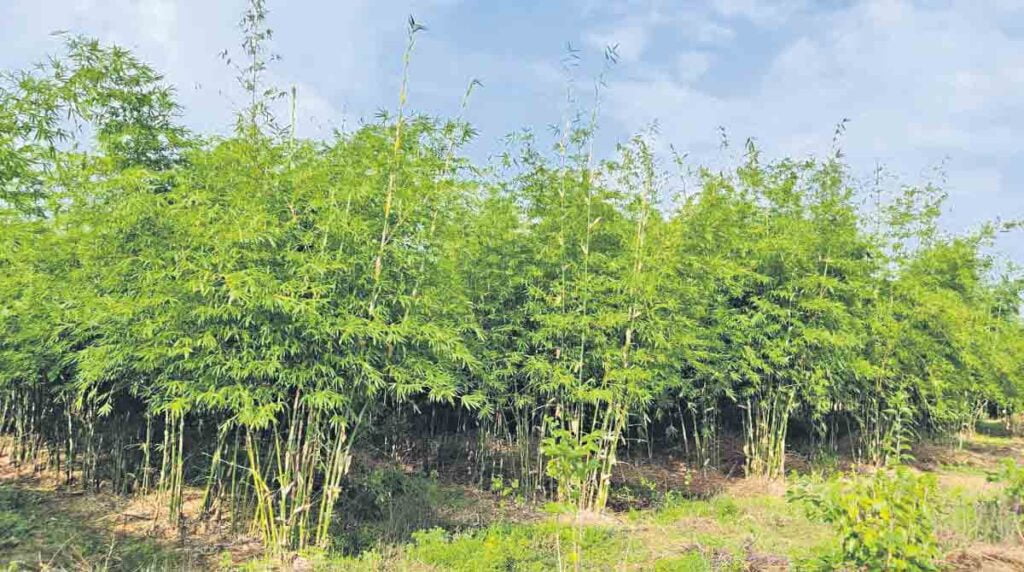Breath of Fresh Air: Bamboo’s Role in Reviving Delhi’s Air Quality and Public Health
In the throbbing heart of India, Delhi, a formidable adversary has been strengthening its grip – air pollution. Ranking as the world’s most polluted capital for the third consecutive year in 20211, Delhi faces an air quality crisis that requires immediate attention. This blog uncovers the remarkable potential of bamboo – the ‘green gold’ – as a solution for cleaner, healthier air in Delhi.
The Dark Cloud Over Delhi: Air Pollution
Delhi’s air pollution dilemma is a persistent concern, spiking notably during the winter months. Various contributors exacerbate the city’s air quality, with PM2.5, PM10, nitrogen oxides, and sulfur dioxide being the main pollutants. These originate primarily from vehicles, industries, and crop residue burning2.
This persistent pollution significantly affects the health of Delhi’s residents, causing respiratory conditions like asthma, cardiovascular diseases, and even cognitive decline3.
| Major Pollutants in Delhi’s Air | Source |
| PM2.5 and PM10 | Vehicles, Industries, Crop residue burning |
| Nitrogen Oxides | Vehicles, Industries |
| Sulfur Dioxide | Industries |
Reference: Central Pollution Control Board2
Impact of Air Pollution on Health in Delhi
Air pollution in Delhi has significant implications for public health, both in the short term and long term. Short-term effects include issues such as eye irritation, respiratory issues, headaches, and dizziness. However, the long-term effects are even more alarming.
Long-term Health Implications
Long-term exposure to high levels of air pollution can lead to severe health issues such as:
- Respiratory diseases: Chronic Obstructive Pulmonary Disease (COPD), asthma, and lung cancer are often associated with prolonged exposure to polluted air.
- Cardiovascular diseases: Studies have indicated a link between air pollution and an increased risk of heart attacks, heart disease, and stroke.
- Neurological effects: Recent research has suggested a potential link between air pollution and cognitive decline, neurodevelopmental issues in children, and an increased risk of neurodegenerative diseases such as Alzheimer’s and Parkinson’s disease.
- Premature death: The World Health Organization (WHO) estimates that around 7 million premature deaths worldwide are linked to air pollution each year, many of which occur in polluted cities like Delhi.
| Health Impact | Condition |
| Respiratory | COPD, Asthma, Lung cancer |
| Cardiovascular | Heart disease, Stroke |
| Neurological | Cognitive decline, Neurodevelopmental issues, Neurodegenerative diseases |
| General | Premature death |
Reference: World Health Organization
Health Forecast for Delhi
As Delhi continues to grapple with severe air pollution, the future health forecast is concerning. If current trends continue, it is expected that incidences of the health conditions mentioned above will continue to rise.
According to a report by the Health Effects Institute and Institute for Health Metrics and Evaluation, it is estimated that, by 2030, the annual premature deaths due to air pollution in Delhi could increase by around 30%.
| Year | Projected Annual Premature Deaths due to Air Pollution (Increase %) |
| 2030 | 30 |
Reference: Health Effects Institute and Institute for Health Metrics and Evaluation
Air pollution is a pressing public health concern for Delhi. The adverse effects on respiratory, cardiovascular, and neurological health pose a significant threat to the city’s population. If current trends persist, the future health implications could be even more severe. Concerted efforts, therefore, are urgently needed to mitigate the problem of air pollution in Delhi. Strategies to achieve this can range from regulatory measures to reduce emissions to greener initiatives such as bamboo plantations.
Bamboo: The Green Lungs and Health Saviour of Delhi
Bamboo emerges as a promising ally in this fight. Known for its fast growth, bamboo can sequester up to 400 tonnes of carbon per hectare over its lifecycle4. Additionally, it generates 35% more oxygen than equivalent stands of trees5, a breath of fresh air for Delhi’s residents. Bamboo leaves also absorb up to 17.5 µg/cm² of PM2.56, potentially reducing the harmful particulates suspended in the air.
The impact on public health? Cleaner air could mean a reduction in respiratory issues, fewer hospital admissions, and an overall improvement in the city’s public health profile.
| Benefits of Bamboo Plantation | Impact |
| Carbon sequestration | Absorption of up to 400 tonnes of carbon per hectare over its lifecycle4 |
| Oxygen production | Generation of 35% more oxygen than equivalent stands of trees5 |
| PM2.5 absorption | Absorption of up to 17.5 µg/cm² of PM2.5 by bamboo leaves6 |
References: Forest Ecology and Management4, Journal of Sustainable Forestry5, Institute of Subtropical Agriculture, Chinese Academy of Sciences6
Bamboo has been gaining global attention due to its various environmental benefits, including its capacity to absorb greenhouse gases, produce oxygen, and curb soil erosion. This fast-growing plant can play a substantial role in curbing air pollution, and it is worth considering its potential in more detail.
- Bamboo and Carbon Sequestration
One of the primary ways in which bamboo helps reduce air pollution is through carbon sequestration. A study published in “Forest Ecology and Management” revealed that certain species of bamboo could absorb up to 400 tonnes of carbon per hectare over its lifecycle – significantly more than certain tree species.
| Carbon Sequestration (tonnes/hectare/lifecycle) | |
| Certain Bamboo Species | 400 |
Reference: Forest Ecology and Management
- Bamboo and Oxygen Production
Not only is bamboo an effective carbon sink, but it also produces substantial amounts of oxygen. This capability helps improve the air quality in its vicinity. A study from the “Journal of Sustainable Forestry” indicates that certain bamboo species release 35% more oxygen than equivalent stands of trees, which can significantly contribute to air purification.
| Oxygen Production (% more than equivalent stands of trees) | |
| Certain Bamboo Species | 35 |
Reference: Journal of Sustainable Forestry
- Bamboo and Particulate Matter
A study conducted in the Institute of Subtropical Agriculture, Chinese Academy of Sciences, revealed that bamboo can also absorb particulate matter. Specifically, bamboo leaves can absorb up to 17.5 µg/cm² of PM2.5, which makes it a promising tool in reducing harmful particulates in the air.
| PM2.5 Absorption (µg/cm²) | |
| Bamboo leaves | 17.5 |
Reference: Institute of Subtropical Agriculture, Chinese Academy of Sciences
- Bamboo Plantations and Urban Development
Bamboo’s potential for improving air quality is not confined to its biological capabilities. Its role in sustainable urban development can also contribute to mitigating air pollution. For instance, bamboo can be used as a building material in place of more energy-intensive materials like cement, steel, or plastics, leading to a lower carbon footprint.
A report from the International Network for Bamboo and Rattan (INBAR) suggests that using bamboo for construction could reduce emissions by up to 1 tonne of CO2 per square meter of housing.
| Emissions Reduction (tonnes of CO2/square meter of housing) | |
| Bamboo-based construction | 1 |
Reference: International Network for Bamboo and Rattan (INBAR)
Pathway to a Cleaner and Healthier Delhi
Making Delhi greener and healthier is a multi-step journey that demands a comprehensive approach. Here’s how we could incorporate bamboo into Delhi’s urban landscape:
- Site Identification: Choose areas across Delhi where bamboo can be planted, focusing on major roads, highways, and high pollution zones.
- Bamboo Species Selection: Pick a bamboo species that will adapt well to Delhi’s climate and require minimal care.
- Plantation and Maintenance: Develop a care strategy that includes regular watering, fertilization, and protection against pests and diseases.
- Impact Evaluation: Regularly monitor the bamboo’s health and its effect on air quality to measure the success of this initiative.
While bamboo shows promising potential, it should be part of a more extensive strategy to combat air pollution, including emissions reduction from major sources.
To summarise, bamboo, the “green gold,” holds immense promise in our battle against air pollution. By integrating bamboo into our urban landscapes and daily lives, we can contribute to a cleaner, healthier environment.
Let’s transform Delhi from the world’s most polluted capital to a model green city with the power of bamboo. Because every breath matters.
Breathe Bamboo, Breathe Fresh.
References:
- IQAir. (2022). World Air Quality Report.
- CPCB. (2022). Air Quality Data.
- WHO. (2022). Ambient air pollution: Health impacts.
- Forest Ecology and Management. (2019). Carbon Sequestration by Bamboo.
- Journal of Sustainable Forestry. (2020). Oxygen Production by Bamboo.
- Institute of Subtropical Agriculture, Chinese Academy of Sciences. (2017). The Effect of Bamboo Leaf Morphological Characteristics on PM2.5 Adsorption.
- United Nations Industrial Development Organization. (2020). Climate Benefits of Sustainable Bamboo Housing.





1 Comment
Jagmohan Maurya
मै दो भाई है हमारे पास तीन ऐकड खेत सीतापुर यूपी में है मै लखनऊ में रहता हूँ। गनूने की खेती कराता हूँ, क्या बांस की खेती में जाने पर फायदा होगा यदि हां तो कैसे?